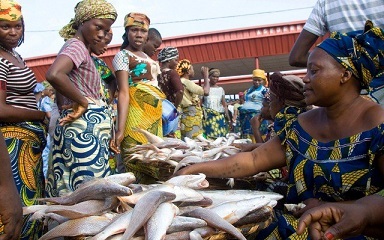
info.afrindex.com
China-Africa Trade Information Service

info.afrindex.com
China-Africa Trade Information Service

Image from hausa.premiumtimesng.com
Although Nigeria's coastline is 853 kilometers,as well as mangrove swamps, creeks, coastal rivers and offshore waters, Nigeria still relies on fish imports to meet daily needs.
Despite having a coastline of 853 kilometres bordering the Atlantic Ocean, as well as fresh and mangrove swamps, creeks, coastal rivers, estuaries, bays, and near and offshore waters, it is ironic that Nigeria still depends on fish importation to meet most of her fish demands.
According to the 2016 Nigeria Fisheries Statistics report, annual fish demand is estimated at 3.32 million metric tonnes - an unsurprisingly high number considering Nigeria's teeming population of about 186 million people - but domestic production produces only about 1.12 million metric tonnes. This leaves a deficit of 2.2 million metric tonnes, which is largely supplied through fish importation.
Nigeria is the fourth largest importer of fish in the world, following China, Japan and the United States. Frozen fish varieties include mackerel (locally called titus or alaran), herrings (locally called shawa), horse mackerel (locally called kote), blue whiting (locally called panla), Argentina silus (locally called ojuyobo) and the popular croaker fish.
The country's top suppliers are the United States and Chile, but fish is also sourced from Europe, Asia, and a few African countries, including Mauritania, Algeria, and Mauritius.
The issue of imports exceeding exports in Africa is not confined to Nigeria alone; however, other African countries like Ghana and Côte d’Ivoire are supplied by fellow African countries- Morocco and Namibia. In fact, two-thirds of Ghana’s fish supply is from these exporting African countries.
Despite these concerns, industrial fishing contributes very little to domestic fish production. Instead, fish production primarily comes via artisanal fishing practices and aquaculture. According to the 2017 report on Nigeria's fish production by the National Bureau of Statistics, out of 5.79 million tonnes of fish produced between 2010 and 2015 in Nigeria, industrial production of fish and shrimp is summed up to 204,403 metric tonnes.When compared with fish production from the other sectors - artisanal and aquaculture, industrial fishing contributes only 4%.
Industrial fishing is not as productive as expected because most people in the business cannot afford the vessels and equipment required for intense commercial fishing on the high seas. Most current fishing vessels in Nigeria are old and are only capable of fishing at 0 to 50 meters below sea level, and this range is only considered suitable for artisanal fishing, thereby limiting capability of resource exploitation on the high seas.